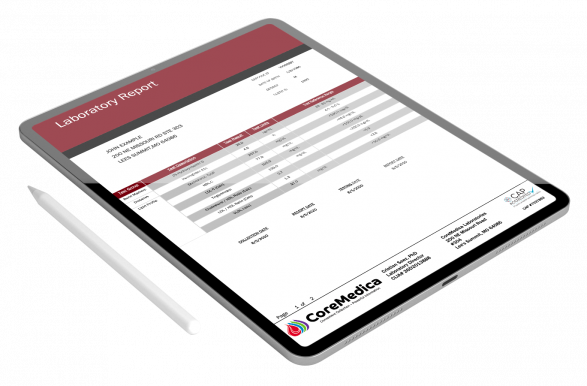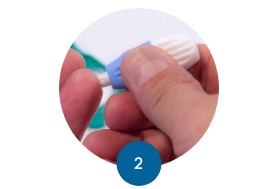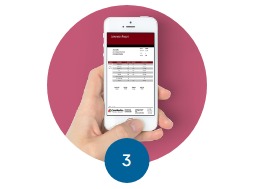Vitamin D Test
Measure Your Personal Vitamin D Levels and Compare It To Healthy Ranges

Vitamin D Test
Measure Your Personal Vitamin D Levels and Compare It To Healthy Ranges

- Easy to use home vitamin D test kit
- Accurate and detailed vitamin D results
- Analysis by a CoreMedica laboratory
- Personalised supplementation plan
- Easy to use home vitamin D test kit
- Accurate and detailed vitamin D results
- Analysis by a CoreMedica laboratory
- Personalised supplementation plan
Vitamin D Test
Measure Your Personal Vitamin D Levels and Compare It To Healthy Ranges
Certified Labs Blood Spot Collection Secure Data
- Easy to use home vitamin D test kit
- Accurate and detailed vitamin D results
- Analysis by a CoreMedica laboratory
- Personalised supplementation plan
30 Day Money Back Guarantee

Vitamin D Test
Measure Your Personal Vitamin D Levels and Compare It To Healthy Ranges
Certified Labs Blood Spot Collection Secure Data
- Easy to use home vitamin D test kit
- Accurate and detailed vitamin D results
- Analysis by a CoreMedica laboratory
- Personalised supplementation plan
30 Day Money Back Guarantee

This test measures your vitamin D (25-OH D) levels.
Your test results will show your vitamin D level and whether it is suboptimal, adequate, or elevated. Vitamin D has many important roles in the body, including bone building and immune function, among others. Checking your vitamin D level can help you understand if you’re maintaining an adequate level of this important vitamin.
Vitamin D
Vitamin D helps keep your bones healthy and strong. It forms in the body when sunlight is absorbed by your skin. Though vitamin D deficiency is quite common—and a low vitamin D level can cause symptoms like fatigue and sleep issues—it can usually be reversed. Vitamin D testing can help you learn if your levels are too low.
Experiencing symptoms such as joint pain, muscle pain, fatigue?
Vitamin D helps keep your bones healthy and strong. If you have too much or little vitamin D, your body may experience symptoms.
Bone Pain
- Brain Fog
- Weakness
- Joint pain
- Muscle pain
- Fatigue or feeling tired
Everything you need to understand your results
Your test results will show your vitamin D level and whether it is suboptimal, adequate, or elevated. Vitamin D has many important roles in the body, including bone building and immune function, among others. Checking your vitamin D level can help you understand if you’re maintaining an adequate level of this important vitamin.
- Detailed directions to guide you
- Pre-paid shipping both ways
- Digital and Printable Results
- All materials for sample collection
- Help along the way if you need it
This test measures your vitamin D (25-OH D) levels.
Vitamin D
Experiencing symptoms such as joint pain, muscle pain, fatigue?
Vitamin D helps keep your bones healthy and strong. If you have too much or little vitamin D, your body may experience symptoms.
Bone Pain
- Brain Fog
- Weakness
- Joint pain
- Muscle pain
- Fatigue or feeling tired
Everything you need to understand your results
Your test results will show your vitamin D level and whether it is suboptimal, adequate, or elevated. Vitamin D has many important roles in the body, including bone building and immune function, among others. Checking your vitamin D level can help you understand if you’re maintaining an adequate level of this important vitamin.
- Detailed directions to guide you
- Pre-paid shipping both ways
- Digital and Printable Results
- All materials for sample collection
- Help along the way if you need it


Certified Labs
CoreMedica laboratory is CLIA -certified. This means they have to meet high standards to obtain both state and federal certifications and submit themselves to regular inspections.

Blood Spot Collection
CoreMedica’s Blood Spot Collection is a quick and convenient way to collect a blood sample for laboratory analysis. The sample can be collected in the privacy of the patients home, at the office, or just about anywhere and at any time.

Secure Data
CoreMedica is HIPAA compliant and takes your privacy very seriously. Your data is stored securely, and under no circumstance do we ever sell your data.
Digital Results
Results you can understand sent to your device


Easy to Understand
Gain meaningful insights about your health with easy-to-understand test results. We also provide you with additional resources and helpful tips along the way.

Personalized
View a personalized report of each marker tested as well as detailed information about what your results mean for you.

Actionable
Take action on your health and wellness. Use your report to help guide your next steps. Get advice from a healthcare professional to learn more about your results.
How It Works
Collect your sample at home and mail it back

Register your kit
Once your test kit arrives, please watch the collection instruction video before you start. Find the link below.
Watch video before opening the pack

Collect your sample at home
You collect your sample in the comfort of home and mail it to a certified lab with prepaid shipping.
Download Full Instructions

Receive results in days
Within days you'll receive your digital results and useful insights on our secure platform.
Reviews
100% would recommend to a friend
5 Star
85%
4 Star
14%
3 Star
1%
2 Star
0%
1 Star
0%
5 Star
4 Star
3 Star
2 Star
1 Star
BUY MORE & SAVE MORE
Have a Question?
See Our FAQs
Why is vitamin D important?
This at-home vitamin D blood test lets you test for vitamin D deficiency or toxicity in the comfort of your own home with just a simple finger prick. But why does vitamin D matter in the first place?
Vitamin D plays a vital role in the body’s ability to regulate the absorption and levels of calcium and phosphorus. It also greatly influences your ability to maintain a healthy bone structure, reduce inflammation, and promote cell growth.
Commonly referred to as the “sunshine vitamin,” vitamin D is a fat-soluble vitamin and is stored in the fatty tissues of the body, which is then released when not in direct sunlight. We typically get 50-90% of our vitamin D from the sunlight itself, with the remainder coming from our diet, where it is mostly found within fatty fish (sardines, salmon, mackerel etc.), egg yolks, and fortified dairy products.
Lack of vitamin D or severe vitamin D deficiency is also believed to cause an increased risk of serious illnesses like:
- Cardiovascular Disease
- Many Different Types of Cancer (such as breast cancer)
- Diabetes
- Dementia
- Alzheimer’s
- Erectile Dysfunction
- Infertility
- Parkinson’s Disease
- Multiple Sclerosis
- Osteoporosis
- Osteoarthritis
- Rheumatoid Arthritis
- Psoriasis
- A Variety of Autoimmune Diseases
- Fibromyalgia
- Periodontal Disease
- Schizophrenia
Some Symptoms of Vitamin D Deficiency
Vitamin D is widely known to be essential for strong bones as it helps the body use calcium, but if you have low vitamin D levels there are a wide variety of other symptoms one can experience:
- Bone Pain
- Fatigue
- Brain Fog
- Depression
- Joint Pain
- Muscle Weakness or Pain
Your results will contain your personal level of vitamin D and whether it is low, normal, or high as compared to someone who shares a similar demographic profile as you (age, gender, etc.).
If your results indicate that you may have vitamin D insufficiency, we can provide guidance and general recommendations to help improve low vitamin D levels. We might also suggest other lifestyle changes that are often helpful in getting your body’s levels within the recommended range.
Vitamin D Deficiency
Low vitamin D levels can result in vitamin D deficiency. Vitamin D deficiency can lead to symptoms like fatigue, depression, and joint pain—and more. In addition, a low vitamin D level may also be linked to serious health conditions like heart disease and bone weakness (in the form of osteomalacia).
The main cause of vitamin D deficiency is a lack of sun exposure. That’s because your body makes vitamin D when your skin comes into contact with sunlight. Dietary sources of vitamin D are few and far between, so sunlight is actually the body’s main source of vitamin D. Fortunately, an at-home vitamin deficiency test that checks vitamin D levels can help you find out if you’re getting enough of this key nutrient.
Risk factors for vitamin D deficiency include the following:
- History of gastric bypass surgery
- Dairy allergies
- Lactose intolerance
- Vegan or ovo-vegetarian diets
- Fat malabsorption conditions, such as celiac disease, ulcerative colitis, and Crohn’s disease
Healthcare providers often prescribe a high-dose vitamin D dietary supplement to help reverse vitamin D deficiencies as quickly as possible. (However, because too much vitamin D supplementation can result in toxicity, be sure you talk to your healthcare provider before taking high doses of vitamin D.)
Vitamin D Toxicity
Too much vitamin D supplementation can result in vitamin D toxicity—meaning your body is getting too much vitamin D. Toxicity is the opposite of vitamin D deficiency, and is linked with excess calcium absorption (which can lead to a condition known as hypercalcemia).
Common symptoms of vitamin D toxicity include:
- Kidney stones
- Anorexia
- Diarrhea, constipation, nausea, and vomiting
- Bone pain
- Frequent urination
- Drowsiness
- Constant headaches
- Irregular heartbeat
How does the Drop Test Kit work?
The Drop Test Kit is an easy way to check your vitamin D level. Here’s how it works:
- Prepare for Collection
- Retrieve Blood Collection Device from foil pouch.
- Remove barcode label from Test Requisition & Consent Form and affix label to the top portion so it is visible after closing the device.
- Place device with collection side up, on a flat and level surface.
- Do NOT remove clear cover.
- Lance Finger
- Rinse hands in warm water
- With palm facing up, select ring finger for your collection. Puncture site should be on the right side of the fingertip for ease of collection. Middle finger may be used, but ring finger is preferred.
- Clean with alcohol pad.
- Stimulate blood flow to the selected finger by letting your hand hang at your side and shaking back and forth for 15-20 seconds.
Note: Do NOT use the center of the fingertip. Only use side of fingertip pad as the puncture site for less discomfort - Using lancet provided, twist off cap. Place hand, palm side up on table or hard surface.
- Position lancet on right side of ring finger as shown. Press lancet into fingertip to puncture site.
- Wipe off the first blood drop with the gauze pad. Keep the gauze pad until you are done.
- Discard used safety lancet in regular trash.
- Apply 4 Blood Drops
- Blood should begin to flow freely
- Allow large drops to form. If blood drop does not form, wipe with gauze pad again and gently massage finger from the palm to fingertip.
- FOUR (4) large blood drops are required to fall in the center of the clear cover applicator.
- Apply drops continuously. Do NOT STOP and wait between drops.
- If blood flow stops, repeat step #2 as needed to generate blood flow.
- After applying 4 drops, wait 3 minutes for blood drops to soak into the white membrane.
- Close the Blood Collection Device
- After 4 blood drops are absorbed, close the device firmly by folding over the top. Make sure the latches are secure. Lay on flat surface.
- Proper Device Handling. After use, the Collection Device containing your blood sample can be stored at room temperature (65°-72°) before mailing to the laboratory.
Sample must be shipped within 24 hours of collection
- Mailing Instructions (Mail Sample within 24 hours of collection)
- Verify all information is correct on the Test Requisition Form, sign and date where indicated. The Laboratory will NOT process your sample without the date of collection and your signature.
- Verify blood collection device is closed securely and a barcode label is affixed on top of the collection device.
- Remove one barcode label from Test Requisition Form and affix on the Participant Card located on the back of this instruction and retain for your reference. Check your status and get your results at: www.DBSLabPortal.com
- Seal envelope and drop in any US Mail Box.
What is vitamin D3 testing?
Vitamin D exists in the body in several different forms, one of which is 25(OH)D—or vitamin D3. Vitamin D3 tests (like the Drop Test Kit) measure the D3 form of vitamin D because this is generally the best way to determine the body’s vitamin D status.
What’s the normal range for vitamin D levels?
Medical and scientific experts have determined the approximate range for adequate or normal vitamin D levels:
A vitamin D level less than about 30 nanograms/milliliter (ng/mL) is considered inadequate by the Endocrine Society.
On the other end of the range, a vitamin D level above 100 ng/mL is often viewed as too high. That’s because vitamin D levels higher than 100 ng/mL increase the risk of hypercalcemia (“hypercalcemia” refers to too much calcium in the blood, which can lead to kidney stones, weak bones, and more).
It’s important to keep in mind, however, that optimal vitamin D levels vary from person to person (depending on the health conditions someone has, for example)—so it’s a good idea to share vitamin D test results with your healthcare provider.
What will my vitamin D test result tell me?
Your vitamin D test result will tell you how high or how low your vitamin D level is, reported in nanograms per milliliter (ng/mL). You’ll also get practical suggestions—including ideas for maintaining healthy vitamin D levels (like getting the right amount of sunlight exposure)—that can help you get the most out of your results.
Why is vitamin D testing (or “vit D testing”) important?
Vitamin D blood tests measure your blood’s concentration of vitamin D and can help you detect a deficiency in this important vitamin. Vitamin D testing also lets you see if you’re getting too much of the “sunshine vitamin” through over-supplementation. (It’s possible to have elevated levels if you use vitamin D supplementation and/or eat fortified foods that have vitamin D.)



